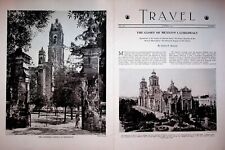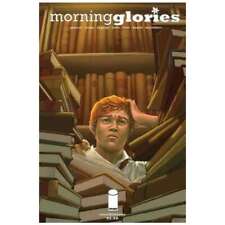|

On eBay Now...
1931 Glory of Mexico's Cathedrals - 9-Page Vintage Travel Architectural Article For Sale

When you click on links to various merchants on this site and make a purchase, this can result in this site earning a commission. Affiliate programs and affiliations include, but are not limited to, the eBay Partner Network.

1931 Glory of Mexico's Cathedrals - 9-Page Vintage Travel Architectural Article:
$20.13
Yes we combine shipping for most multiple item purchases.Add multiple items to your cart and the combined shipping total will automatically be calculated.
1931 Glory of Mexico's Cathedrals - 9-Page Vintage Travel Architectural Article
Original, Vintage Magazine articlePage Size: Approx. 10" x 13" (25 cm x 32 cm) each pageCondition: Good
THE CATHEDRAL GATEWAY AT TEPOZOTLANThe Cathedral of Mexico City is perhaps the most impressive of all the monuments to the architectural genius of Colonial Spam. A gigantic struc-ture of basalt and gray sandstone, said to be the largest church edifice on this continent, the cathedral was begun in 1573 and completed nearly acentury later in 1667.THE GLORY OF MEXICO’S CATHEDRALSMonuments to the Genius of Colonial Spain—The Finest Churches of theWestern Hemisphere—The Religious Pageant in Old MexicoMEXICO is richer in ecclesiastical architecture than any othercountry of the Western Hemisphere. Not only is the cap-ital a city of domes and towers; the churches of Mexicoare scattered lavishly from one end of the country to the other.From the top of the pyramid at Cholula, near Puebla, one maysee as many as thirty churches, and not a few of them are archi-tectural gems. Even on isolated roads or in deserts or in lowlymining regions, one comes upon buildings of amazing beauty.The Spanish Colonials were the greatest builders since theRomans. Upon this land they called “New Spain” they lavishedtheir genius, endowing it with a civilization monumentally ex-pressed in terms of churches and convents, government palaces,residences, hospitals, plazas, acqueducts and fountains. More thanany other part of America, Mexico achieved in enduring archi-tecture a complete expression of a period and a people.And since Spanish-Colonial architecture in Mexico representsHugo lifetimeTHE CATHEDRAL OF TAXCOIn gratitude for the wealth which he secured from the mines of Taxco, the famous magnate, Jose dela Borda, buill this superb cathedral for the mountain town of Taxco in 1757. The cathedral’s elabo-rately carved facade and towers combine elements of both the baroque and churrigueresque style. Theinterior, with its retablos, its carvings, its golden reliefs and its mural decorations, is remarkable for itseffect of exceeding richness.THE MECCA OF RELIGIOUS MEXICOAt Guadalupe-Hidalgo is Mexico’s most sacred and popular shrine—the famous shrine of the Virgin of Guadalupe, which is to Mexicans what theGanges is to the Hindus and Mecca to the Mohammedans. The image of the Virgin, to which from sixty to a hundred thousand Indians pay tributeduring the great pilgrimages, occupies the center of the altar in the Collegiate Church, which is seen in this picture. A statue of the patriot,Miguel Hidalgo, stands in the foreground.the most remarkable excursion in design which developed out ofthe Italian Renaissance, one of the greatest pleasures in travelingthrough this land is to read the reflection in richly carved stoneof those three centuries of Spanish domination in a country whosevitality the Spaniards never completely crushed.From the very start, conditions here were favorable for thedevelopment of architecture on a grandiose scale. The Aztecswere builders of great temples: Cortes himself described themwith admiration in letters he wrote to Charles V. In materials,too, befitting substantial rather than flimsy construction, the coun-try was especially rich. The representatives of the Crown hadample authority for quelling occasionalrevolts among the Indians, and, withpacification insured, prosoerity fol-lowed. The system of government it-self contributed to intense buildingactivity: a union of church and state,it demanded, in order to impose itselfupon the conquered, a semblance ofmight and majesty.Spain had entered Mexico with thesword in one hand and the Gospel inthe other, a Gospel whose pagan ritualat least was familiar and consequentlycomforting to the Indians. So, it is notsurprising to read that by 1596, onlyseventy-five years after the Conquest,over four hundred convents had beenbuilt. Of churches there were a thou-sand in one province alone. At theend of the colonial period, in 1821, thetotal number of churches had reachednine thousand !Fear of this “pagan” land, only re-cently subdued, is reflected in the char-acter of the earliest Spanish buildings.Though admirably placed for effect,like all churches in Mexico, on a slopeor on land artificially raised so as todominate the landscape, these earlystructures recall the royal decrees pro-viding for the fortification of temples,in case of uprisings among the Indians.Medieval in appearance, with greatblank walls, grim battlements and smallentrances, they suggest a suspicion onthe part of the Spaniards that ofthose eight hundred thousand Indianbaptisms achieved within ten years agood part perhaps were only skin-deep.Enclosed by a high, massive walltopped by Moorish battlements andcontaining within a conspicuous tallcross, a cemetery as well as open airmortuary chapels, the plazas of thesechurches like those of the Californiamissions are sanctuaries, the earliestChristian sanctuaries in America.Our California missions are onlycrude, provincial counterparts of thesesixteenth-century Mexican churcheswhose beauty has only recently founda just appreciation. Here, at the verystart, stones speak: the world of me-dieval Spain is giving way to thebrighter one of the Renaissance. Thestyles themselves, often a mixture ofromanesque, mudejar (that used by! theChristianized Moors in Spain) andplateresque (so-called because themolding in low relief resembles thework of silversmiths), were those thenin vogue in the mother country, whereGothic was dying out.Some of these churches might have...
13147-AL-3110-46


1931 Glory of Mexico's Cathedrals - 9-Page Vintage Travel Architectural Article $20.13

Actress Mary Glory riding a bicycle shoes instead real wheels - 1931 Old Photo $5.68

Morning Glories #31 FN 2013 Stock Image $2.70

Morning Glories #31 in Very Fine condition. Image comics [x{ $1.15

Sr Guard Sunny South Sam ( W. Brealey 1931 ) Glory Days of Rail Playing Card $4.95

Colorado Sunshine Vitamins Fun Glory 1931 Vintage Ad Colorado $8.50

Morning Glories #31 VG 2013 Stock Image Low Grade $2.70

Exiles To Glory 31 Elmore 1994 FPG Fantasty Art Trading Card TCG CCG $4.99
|